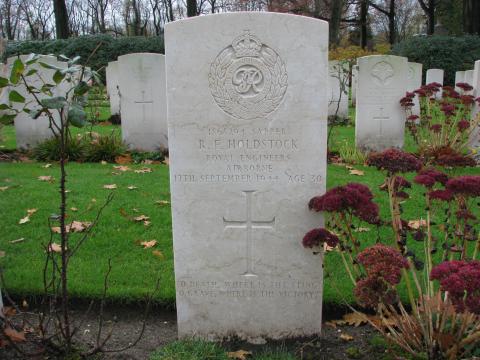Sapper Raymond Francis Holdstock was the son of Frank Holdstock and Mabel Holdstock (nee Baldock), and husband of Emily Holdstock, of Westbrook, Margate.
He originally enlisted with the Royal Engineers prior to the start of the Second World War and served with the 9th Field Company throughout, seeing action in France and Belgium in 1939-40 as part of the rearguards actions protecting the Dunkirk evacuations in early-Summer 1940. After successful evacuation, the Coy was reformed at Monmouth and was continually engaged in Home Defence duties in the UK for almost two years.
Early in 1942 the Company was selected to train as an airborne unit and during the period of transition was stationed at Bulford. By May 1942 they were re-designated as the 9th Field Company R.E. (Airborne) and, on 19 June 1942, became part of the 1st Airlanding Brigade, 1st Airborne Division. All personnel in the Company were trained as glider-borne troops. A significant proportion of the Company’s strength, including Sapper Holdstock also trained as parachutists at Ringway, Manchester; their drop zone being at Tatton Park, near Knutsford.
Sicily and Italy
On 16 April 1943 the Company sailed from Gourock, on the River Clyde, in the liner Boissevain bound for North Africa. On 9/10 July 1943, the Company, as part of the 1st Airlanding Brigade, was engaged in Operation Ladbroke, the first of two hazardous glider landings in Sicily. Some men from the 9th assisted in the capture of the Ponte Grande bridge near Syracuse and others in the Company dealt with coastal defences which could be an impediment to the main invasion force. After being relieved by the advance spearhead of the invasion force, on 16 July, they were taken back to Tunisia in Infantry Landing Craft.
On 8 September 1943, the whole Company sailed from Bizerta in the American cruiser U.S.S. Boise for Operation Slapstick, as part of the invasion of mainland Italy, and during the voyage they learned that the Italian forces had capitulated. They landed at the port of Taranto and for the next month they carried out various tasks including repairs to the dock and mine clearance. The 9th later moved forward with the advancing forces and on occasions small parties operated behind enemy lines cutting railway lines thereby denying the Germans reinforcements and supplies. A detachment of eight Sappers under Corporal Roy Allen sailed in an Infantry Landing Craft to Salerno where they cleared about 700 mines from the beaches.
Operation Market Garden
The 9th returned to the UK in SS Duchess of Bedford, landing at Liverpool on 12 December 1943 and moved to Lincolnshire. Company H.Q. was in the village of Tattershall and their billets were in the nearby village of Coningsby. The 9th soon became involved in a series of exercises in preparation for the invasion of Western Europe. In May 1944 the Company moved south to Hurn in Hampshire to prepare the airfield for Operation Overlord (D Day). They extended the runway and carried out other construction work before moving back to Lincolnshire in early June. A number of planned airborne operations were abandoned before the Company was finally redeployed in Operation Market (the Airborne element of Operation Market Garden).
Sapper Holdstock was among the gliderborne troops who took part in the Battle of Arnhem, during Op Market Garden to Holland in September 1944. At 1020 hrs on the morning of 17 September, Sapper Holdstock emplaned in Glider Chalk number 386, one of sixteen gliders (Chalk Nos. 381-396, including the ill-fated No.389 which crashed at Double Hills) that took off from RAF Keevil for Arnhem.
Piloted by members of D Squadron, Glider Pilot Regiment, and towed by a Short Stirling from 299 Squadron, 38 Group RAF, Sapper Holdstocks’ Glider landed at 13:40hrs on LZ ‘Z between Wolfheze and Heelsum about eight kilometres west of Arnhem. On landing the undercarriage of his glider came through the floor resulting in Sapper Raymond Holdstock receiving serious wounds. He was rushed to a Medical Dressing Station but was found to be dead on arrival.
Sapper Holdstock died on 17 September 1944, aged 30 years old. He was initially given a field burial in the ‘Onder de Bomen’ General Cemetery at Renkum, before he was later reinterred at Oosterbeek War Cemetery, Arnhem.
Profile created with assistance from Phil Jennett, supplemented by research collated by Harvey Grenville with the help of the Double Hills Memorial Group
Read More

Latest Comments
There are currently no comments for this content.
Add Comment
In order to add comments you must be registered with ParaData.
If you are currently a ParaData member please login.
If you are not currently a ParaData member but wish to get involved please register.